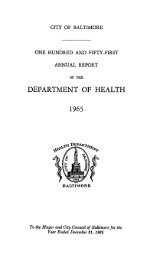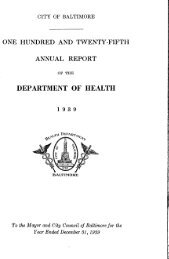Canton - Baltimore City Health Department
Canton - Baltimore City Health Department
Canton - Baltimore City Health Department
Create successful ePaper yourself
Turn your PDF publications into a flip-book with our unique Google optimized e-Paper software.
level rates. These data include only unduplicated complaints made to or fulfilled by <strong>Baltimore</strong> Housing and Community<br />
Development and grouped under “Housing Code Enforcement,” regardless of the outcome of the complaint (e.g. violation,<br />
citation, no action etc).<br />
Food environment<br />
Fast food and carryout data are from the BCHD open food facilities permit/license database, updated June 2009. These data<br />
were geocoded and used to calculate CSA-level densities. The <strong>Baltimore</strong> <strong>City</strong> <strong>Health</strong> <strong>Department</strong> identifies the establishments<br />
as a carryout and then separates the carryouts into chain fast food restaurants and carryouts. Fast food restaurants were<br />
categorized as the following: Blimpie, Burger King, California Tortilla, Chipotle, Dunkin’ Donuts, Five Guys, KFC, Long John<br />
Silver’s, McDonald’s, Popeye’s, Potbelly’s, Quizno’s, Subway, Taco Bell, and Wendy’s. Carryout data in this report reflect<br />
establishments coded as a “carryout” in the database, as well as establishments that were not coded as a carryout but had<br />
“carryout” either 1) in their restaurant name, or 2) on their restaurant signage (verified via Google Street View). Corner store<br />
data are from the Center for a Livable Future and include corner stores, convenience stores, dollar stores, and gas stations with<br />
minimarts. These data were updated January 2011 and used as provided. The travel time to the nearest supermarket was<br />
calculated by Nicole Robinson. To calculate this time, the center of population was calculated for each CSA by identifying the<br />
Census Block Group with the highest population. The geographic center of the most highly populated Census Block Group (i.e.<br />
the center of population) was used as the starting point for each CSA. ArcMap was used to identify the closest supermarket to<br />
the center of population. Google Maps was then used to determine the time it takes to arrive at the nearest grocery store from<br />
the center of population. Google Maps estimates travel time for multiple modes of transportation including walking, driving,<br />
and using public transportation (based on public transportation schedule). A food desert is an area that lacks access to healthy<br />
and affordable foods.<br />
Life expectancy, years of potential life lost, avertable deaths, and mortality rates<br />
Life expectancy, years of potential life lost, avertable deaths, and mortality rates were computed based on death records for<br />
2005-2009 provided by the Vital Statistics Administration at the Maryland <strong>Department</strong> of <strong>Health</strong> and Mental Hygiene, and<br />
population denominators obtained from the Census 2010 Summary File 1 for <strong>Baltimore</strong> <strong>City</strong>, Maryland.<br />
Maternal and child health<br />
Lead poisoning: 2008 lead poisoning data were from the Maryland <strong>Department</strong> of the Environment, Lead Poisoning Prevention<br />
Program.<br />
Birth outcomes: 2005-2009 <strong>Baltimore</strong> <strong>City</strong> birth outcomes were computed from birth records provided by the Vital Statistics<br />
Administration of the Maryland <strong>Department</strong> of <strong>Health</strong> and Mental Hygiene.<br />
Limitations<br />
Small numbers<br />
Because neighborhoods can have small population sizes in certain age groups, there is the possibility that small differences<br />
could produce large differences in rates. We addressed this potential issue by grouping years together and thereby estimating<br />
rates using larger numbers. Despite this, there is some uncertainty associated with these estimates due to the small population<br />
sizes involved.<br />
Data availability<br />
These reports only contain data on a select set of indicators of health and the social determinants of health among many other<br />
possible indicators. Data were not included for smoking and healthcare-seeking behaviors, diet, exercise, the prevalence of<br />
chronic diseases, disability, drug addiction, and mental illness, air quality measures, stress, and a range of other individual- and<br />
community-level social determinants such as language ability, health literacy, social support, social capital, and social cohesion.<br />
18<br />
<strong>Canton</strong>





